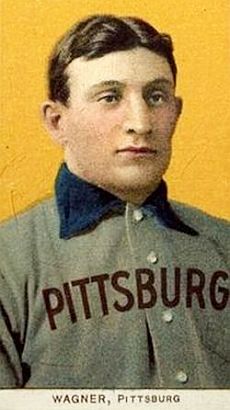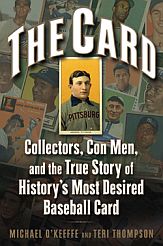The Wagner card had been sold only six months earlier, in February 2007, for a record $2.35 million. But that’s only part of the story. Escalating amounts of money, along with various luminary and ordinary owners, plus a measure of controversy, have followed this card around for nearly a century. More on that in a moment. First, the player whose image is on this highly-valued piece of baseball history.
Honus Wagner was a legendary baseball player who began his professional career with the Louisville Colonels of the National League in 1897. Wagner hit .344 during his rookie year and quickly became one of the best hitters in the National League.
However, in 1899, the NL reduced its membership from twelve to eight teams, and the Colonels were eliminated. Thereafter, and through his remaining career, Wagner played with the Pittsburgh Pirates.
In Pittsburgh, Wagner compiled a stellar record through 1917. He played the infield, primarily shortstop. Wagner had grown up in the Pennsylvania coal fields and worked in the mines as a 12 year-old. His mother called him “Hans,” which over the years became “Honus.”
Babe Ruth once said there was no one who could replace Wagner at shortstop, noting his big hands, that “drew the balls to him.” Former U.S. President, Dwight D. Eisenhower, growing up in Kansas, used to daydream and tell his friend about becoming a baseball player like Honus Wagner.
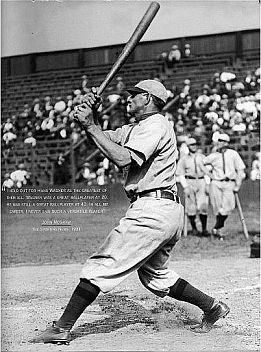
An inscription on this photo reads: “I hold out for Hans Wagner as the greatest of them all. Wagner was a great ball player at 20. He was still a great ballplayer at 43. In all my career I never saw such a versatile player.” John McGraw, mgr., NY Giants, 1931.
‘Holy Grail’ of Cards
The 1909 Honus Wagner baseball card, therefore, honors a great player. But there’s a lot more to this baseball card story than Wagner’s impressive career achievements. The Wagner card — sometimes called the “Mona Lisa” or “Holy Grail” of baseball trading cards — was originally published and released by the American Tobacco Trust in 1909. Only 50 to 60 other Honus Wagner cards are believed to exist (some estimates run as high as 100, though collector quality is a limiting factor). Yet the Honus Wagner card that sold in September 2007 for $2.8 million, was especially rare and in very good, near mint condition.
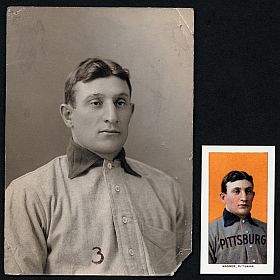
Original portrait photo of Honus Wagner in his Pittsburgh uniform taken by Carl Horner in 1905, from which an artist’s version was later made, adding 'Pittsburgh' to his jersey.
According to his granddaughter, Leslie Wagner Blair, Honus Wagner did care about his fans, and especially young fans. Blair, who knew her grandfather as “Buck,” says in one account that “[h]e loved children. He wanted to teach kids good sportsmanship. When it came time for that card to come out, it wasn’t that he wasn’t paid. He didn’t want kids to have to buy tobacco to get his card.” Yet Wagner himself chewed tobacco, and he had also appeared in or lent his name to tobacco advertisements and products, including a cigar baseball trading card in 1899 and a newspaper ad for Murad cigarettes during the 1909 World Series. It’s possible, of course, that early in his career Wagner did endorse and use tobacco products, but later, changed his mind about endorsements.
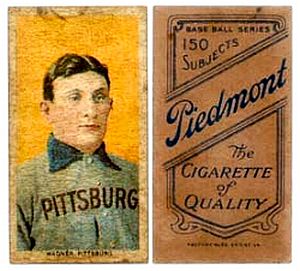
Another Wagner card, worn and weathered, showing the backside Piedmont cigarette advertisement.
However, only three, it is believed, carry a Piedmont cigarette ad, and according to some, make those cards rarer and more valuable. Yet the $2.8 million “Gretsky card” — so named since it was owned in recent years by famous ice hockey star, Wayne Gretsky — has the Sweet Caporal cigarette ad on its reverse side.
This particular card has changed hands four times in the last 10 years (1997-2007), doubling in value on three of those occasions. See small table, later below, “Wagner Card, Escalating Value.”
|
“Celebrity Sell” Star baseball players in the 1890s and early 1900s — the sports celebrities of their day — were sought after for product endorsements and testimonials. Honus Wagner, either by name or likeness, appeared in advertisements for chewing gum, gunpowder, soft drinks, Gillette razor blades, cigars, and other products. In fact, Wagner is believed to be among the first professional athletes to receive endorsement money for allowing the use of his name on a product. He was also among the first professional players to make commercial ties with a sporting equipment company — in this case, Louisville Slugger baseball bats. Wagner first played with the Louisville Colonels professional team in Louisville, Kentucky. There he met and befriended Bud Hillerich, who in 1894 had begun producing a trademarked baseball bat containing the engraved name, Louisville Slugger. Many ball players of that day began to use only Hillerich’s bats, who would also engrave their names on the bats so they could determine which bat was theirs. One of those players was Honus Wagner. When Wagner left Louisville to play for Pittsburgh, he and Hillerich kept in touch and maintained their friendship. In 1905, Wagner signed a contract with Hillerich which allowed him to use Wagner’s signature on baseball bats to be sold in stores. And with that, Wagner became one of the first professional athletes to receive endorsement money by allowing the use of his name on a product for general sale. |

Photograph of a 'Honus Wagner' cigar box.
The Card’s Trail
As early as 1933, a Honus Wagner baseball card was listed in The American Card Catalog of a collector named Jefferson Burdick at a price of $50, making it even then the world’s most expensive baseball card. But the special, mint condition card of recent $2.8 million fame, appears to have surfaced in 1985, when a Long Island, New York sports memorabilia dealer named Bill Mastro purchased it along with 50-to-75 other old cards also in the T206 series.
Mastro bought the “package deal” from a Hicksville, New York collector — Wagner card included — for $25,000. Mastro then sold his card in 1987 to Jim Copeland, a San Luis Obispo, California sporting-goods chain owner and baseball card collector, for $110,000 — a transaction credited with raising interest in baseball card collecting. Copeland, in turn, decided to sell his entire baseball card collection in 1991 — some 873 pieces, including the rare Honus Wagner card.
That sale occurred at the Sotheby’s auction house in New York, where separate action focused on Copeland’s Wagner card. Bidding rose swiftly, jumping from an opening price of $114,000 to $228,000, then $300,000, and finally, $410,000. The full price for the card, with Sotheby’s charge added, was $451,000.
The winning bidder — who had done so by phone — turned out to be National Hockey League star Wayne Gretzky, who had some financial assistance from partner Bruce McNall, the owner of the NHL’s Los Angeles Kings. Once again, publicity surrounding the Sotheby’s auction of the Wagner and other old cards, elevated interest in the baseball card collecting and the sports memorabilia business.
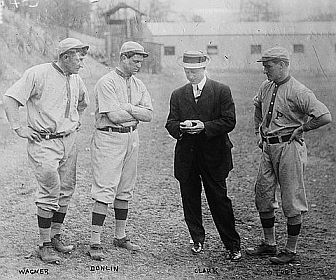
Wagner at left in 1912 photo with Pittsburgh teammates Mike Donlin, manager Fred Clarke and Marty O’Toole.
Sold To Wal-Mart
Wayne Gretzky, however, was not a baseball card collector. He bought the Honus Wagner card for investment purposes. Three years after he acquired it, Gretzky bought out his partner’s share. He then sold the Honus Wagner card in 1995 to Wal-Mart for a reported $500,000. Wal-Mart and Treat Entertainment, an Atlanta, Georgia printing company, used the card as the grand prize in a nationwide contest to promote the sale of new baseball trading cards. They took the highly-prized Wagner card on road tour across the U.S.
In February 1996, on the 122nd anniversary of Honus Wagner’s birthday, a grand prize drawing was held for the Honus Wagner card. The ceremony and drawing were broadcast on CNN’s Larry King Live Show. Brooks Robinson, former Baltimore Oriole baseball star third baseman and Hall-of-Famer, came on the show to select the winning contestant. A Florida postal worker named Patricia Gibbs was the grand-prize winner.
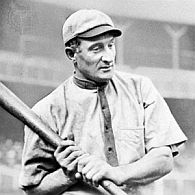
Honus Wagner, circa 1910s.
Wal-Mart and Treat Entertainment officially awarded the card to Gibbs later at a Wal-Mart store in Florida, reportedly delivered by two armed guards. Wal-Mart and Treat Entertainment by this time were reaping handsome returns for their baseball-card publicity campaign, selling more than 30 million baseball card packs in a matter of months. Patricia Gibbs, however, could not afford to pay the taxes on the Honus Wagner card she won in the drawing, and decided to sell the card at Christie’s auction house in New York. In September 1996 the card was sold for $640,500 to an anonymous buyer (later revealed to be Chicago collector, Michael Gidwitz) whose agent said he expected it would soon fetch $1 million or more in later bidding. Sure enough, in the year 2000, Brian Seigel, the CEO of an asset management company, paid a record $1.265 million when he bought the card at auction on e-Bay.
Wagner Memorabilia
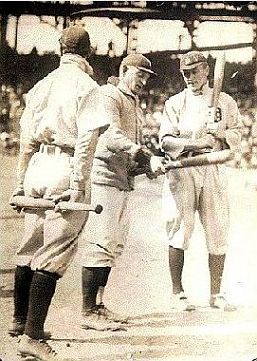
1909 World Series: Honus Wagner at center, Ty Cobb of Detroit at right, and Davy Jones of Detroit with back to camera.
Among the Wagner items auctioned from Blair’s collection was an 11-inch Tiffany sterling chalice, or loving cup, that was presented to Wagner in December 1907 by National League president Harry Pulliam. The cup is engraved with HonusWagner’sname, given him to commemorate the five National League batting titles he had won to that point. He would proceed to win three more batting titles. Legend has it that Wagner was then in an off-season contract dispute and was called to Pulliam’s office in New York to receive the award as a way of placating him. At the auction, the Loving Cup went for more than $93,000.
Also in this auction was a baseball hit by Wagner in the final game of the 1909 World Series — a championship series in which Wagner was matched against rival Ty Cobb and his Detroit ball club. An inscription on the ball reads: “Ball hit by Honus Wagner of Pittsburgh Nationals winning game and championship from Detroit American, Oct/1909. Kindness of Umpire William Klem.”(who apparently gave the ball to Wagner). The 1909 season and that Word Series may well have been the pinnacle of Wagner’s career. He led the Pirates to 110 wins that year, and in the World Series games he outshone rival Ty Cobb and helped Pittsburgh win their first World Series.

The famed 'Wayne Gretsky' Wagner card, graded & framed.
Graded Wagners
A number of other Honus Wagner cards have surfaced in recent years, some fraught with controversy over their authenticity and/or quality. The Honus Wagner card highlighted here, however, was graded in the 1990s when Wayne Gretsky owned it. The card was graded by the Professional Sports Authenticators (PSA), a firm which came into existence about that time, and has since become one of the nation’s leading third-party, sports- card grading services. The Wagner card, in fact, was the first baseball card to be PSA-graded, and it received a NM-MT 8 from PSA, which is a “near mint – mint” rating, the highest given to a T206 Wagner so far.

Honus Wagner in the infield.
“The Card”: New Heights
By 2007, meanwhile, the “Gretsky”card, was about to reach new heights in value. Brian Seigel of Las Vegas, the CEO of Emerald Capital LLC, an asset management company, decided to sell the Gretsky card. In July 2000, he had paid a then-record $1,265,000 for the card at public auction. During his ownership of the card, Seigel had shared it with the public.
|
Wagner Card 1930 $50 |
“Previous owners usually kept it locked up,” explained Seigel, “however, I displayed the card as frequently as possible at major sports collectibles shows around the country. When I lived in Orange County California I even took it to several Cal State Fullerton baseball games and to elementary schools to teach children about baseball card collecting.” The card was also displayed at the Ronald Reagan Presidential Library and Museum in Simi Valley, California in March 2003.
Seigel said he enjoyed owning the card for over six years, and added that during that time it was never for sale. “But I received an unsolicited call out of the blue late last year [2006] from a California collector who wanted to buy it. After thinking it over for a while, I decided to sell, and the two of us agreed on a price.” That price, paid in February 2007, was $2.35 million.
Six months later, in September 2007, the card was sold again, when another collector — later revealed to be Arizona Diamondbacks baseball team owner Ken Kendrick — paid $2.8 million for the card. At the time, that made the “Gretzky” Wagner card, as it has come to be called, the most valuable baseball trading card in history. However, in 2016, another T-206 Wagner, this one a PSA “5-graded” card, slightly larger than the Gretzky and also in pristine condition, having come down from former Vermont owners who passed away, was sold for $3.12 million, making it the most valuable card, at least for the time being. Another card rising in value in recent years is the Mickey Mantle 1952 Topps card, one of which sold for $2.88 million in April 2018 (See story, “Mickey Mantle Day,” for example, for more on his career). But alas, on August 16, 2021, a T206 Honus Wagner card took the high ground once again, selling for $6.606 million, breaking the record for the highest-selling sports card of all time.
Meanwhile, rare card owners like Ken Kendrick and Brian Seigel believe such cards should be available for public viewing. Kendrick, for example, had loaned his Wagner card, and others in his collection, to the Baseball Hall of Fame, which had a travelling show that moved around the country to various venues.

Portion of a full-page 1975 magazine ad featuring the 1909 Honus Wagner card in a solicitation to subscribe to ‘The Sport Hobbyist’ magazine, so readers wouldn’t miss out on deals like the Wagner card that had sold, at that time, for $1,500.
As one measure of the Honus Wagner card’s escalating value in history, consider the magazine advertisement above from a 1975 edition of Hockey World. It’s a solicitation to subscribe to The Sport Hobbyist magazine of that day, but it also explains that a Wagner card had just been sold at that time for $1,500 – up from $200 ten years earlier. David Seideman, writing in Forbes business magazine in November 2014, verified that indeed a Wagner card had been sold for that amount in 1975, and he’d wished he had bought one at that price.
Card Controversy
As the value of the Honus Wagner baseball trading card has escalated over the years, so have claims about finds of other cards — some of which have generated considerable controversy and in a few cases, have become quite messy and nasty battles. Two African American card collectors from Cincinnati, Ohio named John Cobb and Ray Edwards tried to sell a Piedmont-backed Honus Wagner card in 2002 on e-Bay, but ran into a battle over authentication which included various expert reviews, police investigations, charges of fakery and racism, coverage by HBO’s Real Sports with Bryant Gumbel, and attempted sales and shut downs by e-Bay. That card, and its history to August 2006, however, is still posted on some auction sites.
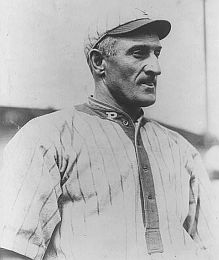
Photo of 'Hans Wagner' dated October 1st, 1914.
The Wagner card saga continues to generate much interest in the world of card collecting and beyond. And to keep things interesting, there is always the possibility of “old card” finds, not only in the T206 American Tobacco collection, but also in a range of other notable “old card” series and their commercial sponsors. In January 2008, a man living in the southeast U.S. discovered 550 old baseball cards in his attic — all from the legendary 1909-1911 T206 series issued by American Tobacco. Among those cards was a Honus Wagner card – a card not in the best of shape and receiving a low grade, but still expected to sell for at least $100,000.
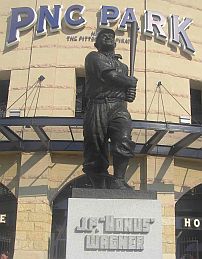
Honus Wagner statue at entrance to Pittsburgh Pirates home stadium, PNC Park, Pittsburgh, PA.
The baseball player at the center of all this, however, Honus Wagner, is the real deal and the genuine item — a great ball player who leaves behind some still amazing achievements. Not only did he hit for an average of .300 or more for 17 consecutive seasons, but in seven of those seasons he hit for .350 or better, finishing his career with a .329 lifetime average. And although he played in an era when “small ball” was the prevailing method of play — with low-scoring games of 2-1, 3-1 and 3-2 being the norm — Wagner still had nine seasons with 100 RBIs or more, winning five RBI titles and six for slugging. He also led the National League in stolen bases on five occasions.
Some baseball historians rank Wagner as the second-best player of all time, behind only Babe Ruth. He was also a decent person by many accounts, respected by those who knew him. Says historian Bill James: “He was a gentle, kind man, a story teller, supportive of rookies, patient with the fans, cheerful in hard times, careful of the example he set for youth, a hard worker, a man who had no enemies and who never forgot his friends. He was the most beloved man in baseball before Ruth.”
In 2003, Wagner was among those baseball greats honored with a commemorative stamp issued by the U.S. Postal Service. In July 2003, the USPS issued its “Legends of Baseball” 33-cent commemorative stamps, honoring a collection of players, including Wagner — a group named the previous year to Major League Baseball’s “All-Century Team.” Among those in addition to Wagner were: Dizzy Dean, Lefty Grove, Jackie Robinson, Ty Cobb, Roberto Clemente, Mickey Cochrane, Eddie Collins, Jimmie Foxx, Lou Gehrig, Josh Gibson, Rogers Hornsby, Walter Johnson, Christy Mathewson, Satchel Paige, Babe Ruth, George Sisler, Tris Speaker, Pie Traynor, and Cy Young.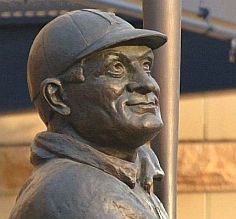
Detailed close-up of Wagner statue at PNC Park. Photo by Jeff Hecker at pbase.com.
See also at this website, “Baseball Stories, 1900s-2000s,” a topics page with links to additional baseball-related stories, and for Pittsburgh fans, “The Mazeroski Moment: 1960 World Series.” For additional sports-related stories at this website see the Annals of Sport category page. Thanks for visiting – and if you like what you find here, please make a donation to help support the research and writing at this website. Thank you. – Jack Doyle
|
Please Support Thank You |
______________________________
Date Posted: 28 May 2008
Last Update: 9 June 2023
Comments to: jdoyle@pophistorydig.com
Article Citation:
Jack Doyle, “$2.8 Million Baseball Card — 1909 Honus Wagner,”
PopHistoryDig.com, May 28, 2008.
_____________________________
Sources, Links & Additional Information
 Ken Kendrick, owner of the Arizona Diamondbacks, holds Gretzky Honus Wagner card he bought for $2.8 million in 2007. |
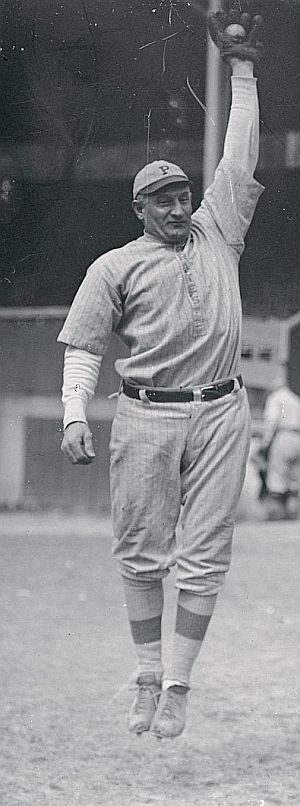 Honus Wagner jumping off the ground to field a ball, undated. |
Ralph S. Davis, “Wagner A Wonder: One Player In Game Who Is Not Money Mad,” The Sporting News, October 12, 1912.
Alexandra Peers, “Baseball’s Card of Cards Is Up for Grabs,” The Wall Street Journal, September 20, 1996.
Dan Barry, “Baseball’s Card of Cards Is Auctioned for $640,500,” New York Times, September 22, 1996.
Dennis DeValeria and Jeanne Burke, Honus Wagner: A Biography, New York: Holt, 1996.
Michael O’Keeffe and Bill Madden, “Wagner’s Wild Card: Mystery Has Surrounded Honus T206 Since 1909”, Daily News (New York), March 25, 2001.
Shelly Anderson, “Honus Wagner’s ‘Honey’ to Offer Rare Memorabilia at Auction,” Pittsburgh Post-Gazette, June 13, 2003.
“Honus Wagner Original T206 Pose Carl Horner Photograph sold for $18,560,” Description written by T206museum.com, May, 2005. (Robert Edward Auctions offered a Honus Wagner Original T206 Pose Carl Horner Photograph at auction and it sold for $18,560 on April 30th, 2005).
“PSA Reports Record $2.35 Million Sale of NM-MT T-206 Honus Wagner Card,” PSAcard.com, February 27, 2007.
Bob Pool, “Honus Wagner Card Sells for $2.35 Million,” Los Angeles Times, February 28, 2007.
Associated Press, “Rare Honus Wagner 1909 Baseball Card Sold for Record $2.8 Million,” September 6, 2007.
Michael O’Keeffe and Teri Thompson The Card: Collectors, Con Men, and the True Story of History’s Most Desired Baseball Card, New York: HarperCollins, 2007.
Michael O’Keeffe, blog, “Collector Finds $300k in Baseball Cards in His Attic.” New York Daily News, January 16, 2008.
For an excellent site on Honus Wagner history, photos, and card collecting see Honus Wagner Blog.
“Honus Wagner,” and “T206 Honus Wagner,” Wikipedia.org.
“Wagner & Louisville Slugger,” Research Paper, University of Maryland.
Bob Diskin, “Easy-Going Honus Was a Pirates Icon,”ESPN.com
For more detail on vintage baseball card collecting, auctions, valuations, etc. see, for example: www.T206.org and www.T205.org
“The Legend of Honus,” (The Brian Seigel Collection), in Stephen Wong and Susan Einstein, Smithsonian Baseball: Inside the World’s Finest Private Collections [ a lavishly illustrated book on baseball card collections], HarperCollins, 2005, pp.59-65.
Michael Zennie, “Sports Memorabilia Dealer Admits He Trimmed Corners on Most Valuable Baseball Card Ever Sold at $2.8million… But the Value Is Likely to Increase,” Daily Mail (London), April 10, 2013.
David Seideman, “The Honus Wagner Baseball Card I Wish I Had Bought Could Have Made Me A Millionaire,” Forbes.com, November 25, 2014.
Ryan Cracknell, “World Record $3.12 Million for T206 Honus Wagner Baseball Card,” Beckett.com, October 1, 2016.
Chris Perez, “Mickey Mantle Baseball Card Sells for $2.8 Million at Auction,” New York Post, April 20, 2018.
